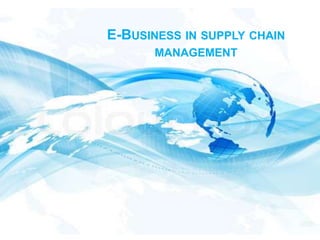Ebusiness and suply chain
•Download as PPTX, PDF•
4 likes•805 views
importance and effect of e business on supply chain management
Report
Share
Report
Share

Recommended
More Related Content
What's hot
What's hot (19)
LOGISTICS AND SUPPLY CHAIN CHALLENGES FOR THE FUTURE

LOGISTICS AND SUPPLY CHAIN CHALLENGES FOR THE FUTURE
8 key benefits of effective supply chain management

8 key benefits of effective supply chain management
Viewers also liked
«Case Study of e-Services Development: New e-Business Idea in the Greek Winte...

«Case Study of e-Services Development: New e-Business Idea in the Greek Winte...Eleftherios Darousis
Viewers also liked (20)
Bridging the Gap Between Different Levels of Business Process Modelling

Bridging the Gap Between Different Levels of Business Process Modelling
Lecture 5 e-cmmerce , how ecommerce changes business, strategy structure -ch...

Lecture 5 e-cmmerce , how ecommerce changes business, strategy structure -ch...
An Investigation of Value Creation through Business Model Innovation in the ...

An Investigation of Value Creation through Business Model Innovation in the ...
«Case Study of e-Services Development: New e-Business Idea in the Greek Winte...

«Case Study of e-Services Development: New e-Business Idea in the Greek Winte...
Supply Chain Management - Supply Chain Management for E Commerce In India 

Supply Chain Management - Supply Chain Management for E Commerce In India
“TO STUDY THE GROWTH OF E-COMMERCE INDUSTRY IN INDIA”

“TO STUDY THE GROWTH OF E-COMMERCE INDUSTRY IN INDIA”
Similar to Ebusiness and suply chain
Business to Business E- Commerce

Business to Business E- CommerceWe Learn - A Continuous Learning Forum from Welingkar's Distance Learning Program.
Similar to Ebusiness and suply chain (20)
Top technology trends in supply chain & logistics industry

Top technology trends in supply chain & logistics industry
Challenges & Application In Industrial IoT by Sachin Pukale, machinepulse

Challenges & Application In Industrial IoT by Sachin Pukale, machinepulse
Four Ways that Technology is Remolding the Digital Supply Chain

Four Ways that Technology is Remolding the Digital Supply Chain
Recently uploaded
Mattingly "AI & Prompt Design: Structured Data, Assistants, & RAG"

Mattingly "AI & Prompt Design: Structured Data, Assistants, & RAG"National Information Standards Organization (NISO)
Explore beautiful and ugly buildings. Mathematics helps us create beautiful d...

Explore beautiful and ugly buildings. Mathematics helps us create beautiful d...christianmathematics
Recently uploaded (20)
Interactive Powerpoint_How to Master effective communication

Interactive Powerpoint_How to Master effective communication
Russian Escort Service in Delhi 11k Hotel Foreigner Russian Call Girls in Delhi

Russian Escort Service in Delhi 11k Hotel Foreigner Russian Call Girls in Delhi
9548086042 for call girls in Indira Nagar with room service

9548086042 for call girls in Indira Nagar with room service
Mattingly "AI & Prompt Design: Structured Data, Assistants, & RAG"

Mattingly "AI & Prompt Design: Structured Data, Assistants, & RAG"
Z Score,T Score, Percential Rank and Box Plot Graph

Z Score,T Score, Percential Rank and Box Plot Graph
Kisan Call Centre - To harness potential of ICT in Agriculture by answer farm...

Kisan Call Centre - To harness potential of ICT in Agriculture by answer farm...
Explore beautiful and ugly buildings. Mathematics helps us create beautiful d...

Explore beautiful and ugly buildings. Mathematics helps us create beautiful d...
Ebusiness and suply chain
- 1. E-BUSINESS IN SUPPLY CHAIN MANAGEMENT
- 2. CONTENTS Introduction Background Functions Impact On Supply Chain Performance Revenue Impact Cost Impact Setting Up E-business Advantages Conclusion Reference 2
- 3. INTRODUCTION Execution of business transactions over the internet. Concerned with the use of the Internet to link companies with their trading partners. 3
- 4. BACKGROUND Other channels were used for transactions EDI-Electronic Data Exchange Evolved significantly since its introduction in the 1990’s in parallel with the rapid rate of development of information technology (IT). IT plays a crucial role in SCM as a key enabler of supply chain integration. 4
- 5. FUNCTIONS Provides information across the supply chain Negotiation of prices Allows customers to place orders Allows customers to track orders Filling and delivering orders Receive payment from customers 5
- 6. 6
- 7. REVENUE IMPACT Offers direct sale customers Provides 24 access from any location Aggregating information from various sources Personalization and customization of information Implements flexible pricing Speeds the time to market Price and service discrimination Efficient fund transfer 7
- 8. COST IMPACT Reduces product handling with a shorter supply chain Decreases inventory cost Decreases delivery cost and time Reduces facility and processing costs Improve SC cordination 8
- 9. SETTING UP E-BUSINESS Integrate the internet with existing physical network Devise shipment strategies that reflect costs Optimize e-business logistics to handle packages not pallets Design e-business supply chain to handle returns efficiently Keep customers informed throughout the order fulfillment cycle 9
- 10. ADVANTAGES Saves money Saves time Easily access of information Easier transaction Updation of new products 10
- 11. CONCLUSION E-business has a vital role to play in SCM Still in the first stages of increasing the recognition of the potential of e-business Have more advantages than disadvantages 11
- 12. REFERENCE Claudia-Maria Wagner and Edward Sweeney, Dublin Institute of Technology, Ireland, “e-Business in Supply Chain Management” IGI Global DOI: 10.4018/978-1-60566-808- 6.ch002 Sunil Chopra and Peter Meindel “Supply Chain Management” http://arrow.dit.ie/nitlbk 12
- 13. 13